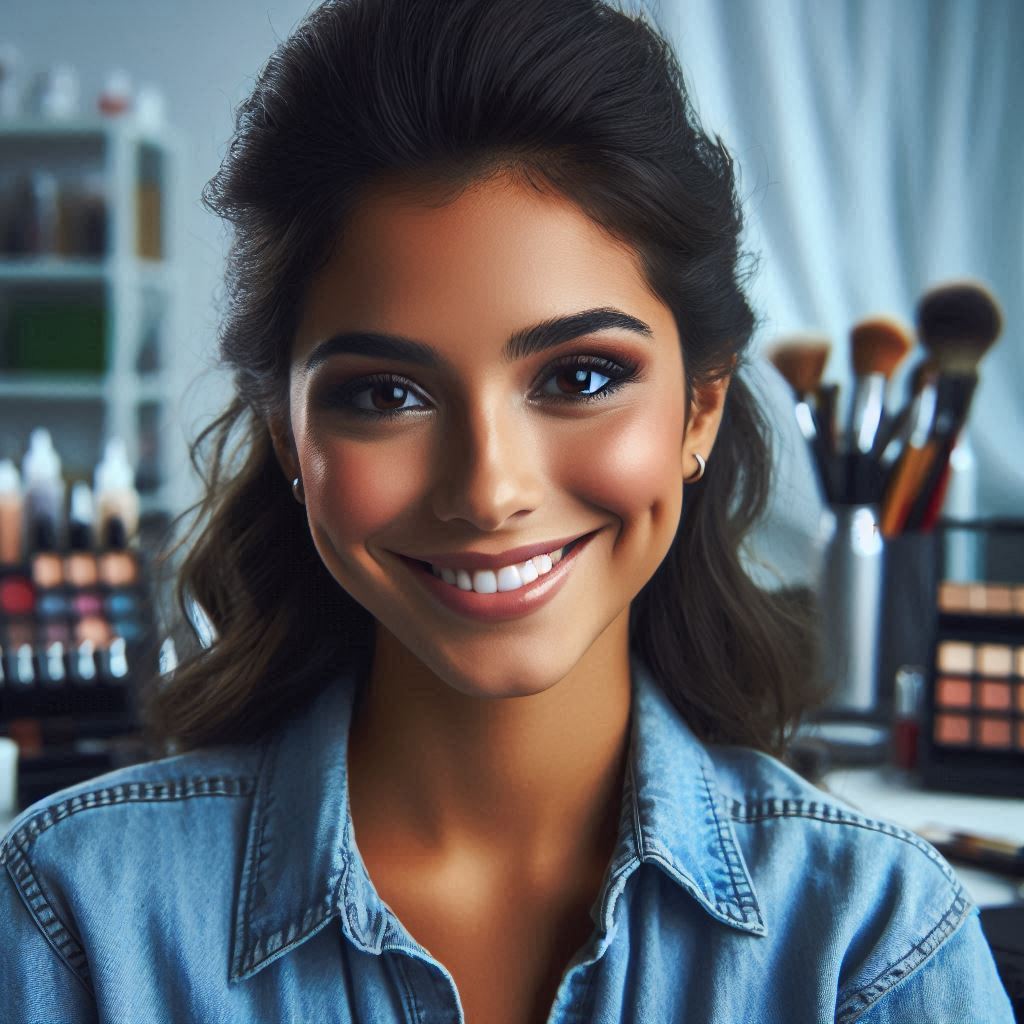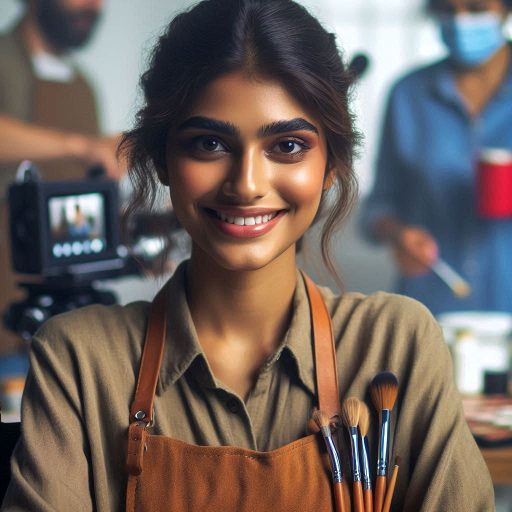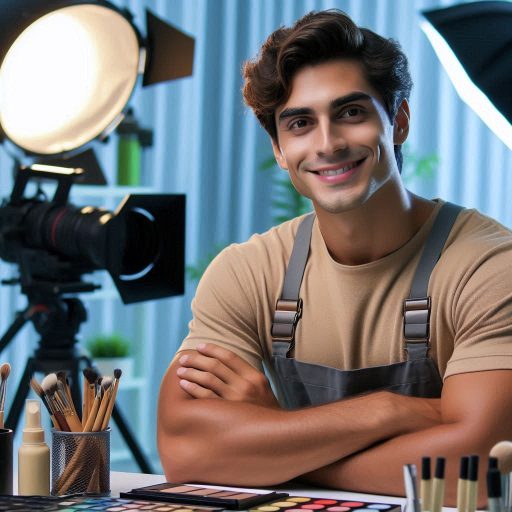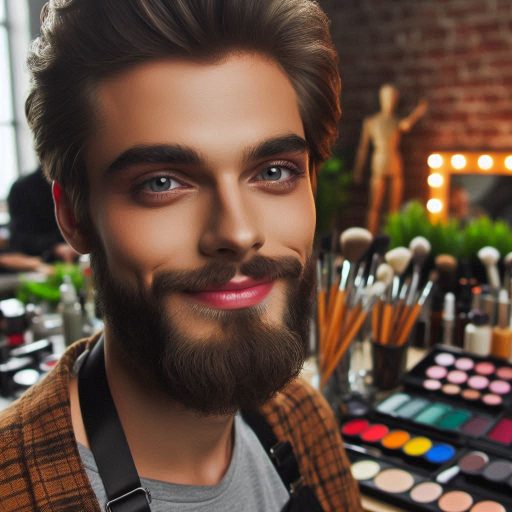Introduction
Special effects makeup involves creating realistic effects like wounds, scars, and monsters.
It plays a crucial role in bringing characters to life in movies, TV shows, and theater.
As a special effects makeup artist, your day begins early with prep work.
Gathering supplies, reviewing designs, and setting up your workstation are essential tasks.
Collaborating with directors and actors to ensure the desired look is achieved.
Creating molds, prosthetics, and applying makeup to transform actors into their characters.
Attention to detail is key as you work meticulously to achieve the desired effect.
Long hours on set, adjusting makeup, and ensuring continuity throughout filming.
Interacting with the production team and actors to make necessary adjustments as needed.
Working in a fast-paced environment to meet deadlines and deliver exceptional results.
Constantly learning new techniques and staying updated on industry trends to grow your skills.
Education and Training
To become a special effects makeup artist, qualifications such as creativity and attention to detail are crucial.
Pursuing different educational paths such as attending a makeup school or learning through apprenticeships is beneficial.
Continuous learning is important to stay up to date on new techniques and products in the industry.
As a special effects makeup artist, the journey to mastering this unique craft requires a combination of talent, education, and hands-on training.
Let’s delve into the qualifications and skills needed to pursue a career in this exciting field.
Qualifications and Skills Needed
To excel in the world of special effects makeup, one must possess a creative flair, keen attention to detail, and a passion for the art of transformation.
This field demands a blend of artistic talent and technical skill, as artists are tasked with creating illusions and enhancing characters through makeup.
Additionally, individuals aspiring to become special effects makeup artists should have a strong foundation in basic makeup techniques, as well as a deep understanding of color theory and anatomy.
This knowledge serves as the building blocks for creating realistic and believable special effects.
Transform Your Career Today
Unlock a personalized career strategy that drives real results. Get tailored advice and a roadmap designed just for you.
Start NowEducational Paths
There are various educational paths one can take to kickstart their career as a special effects makeup artist.
Attending a reputable makeup school or enrolling in specialized courses can provide comprehensive training in the art of special effects makeup.
Alternatively, some aspiring artists choose to learn through hands-on experience by apprenticing under seasoned professionals in the field.
This mentorship allows for practical, real-world exposure to different techniques and workflows, enabling artists to refine their skills through practice and observation.
Importance of Continuous Learning
Special effects makeup is a dynamic and ever-evolving field, with new techniques, products, and trends emerging constantly.
As such, it is vital for artists to stay updated on industry developments and innovations through continuous learning.
By attending workshops, masterclasses, and industry events, makeup artists can expand their skill set, network with other professionals, and stay ahead of the curve in an increasingly competitive market.
Embracing a growth mindset and a commitment to ongoing education is key to thriving in the fast-paced world of special effects makeup.
Read: Famous SFX Artists You Should Know About
Daily Routine
Typical schedule of a special effects makeup artist
A special effects makeup artist’s day starts early.
They often arrive on set before most crew members.
Mornings are crucial for preparation and organization.
Artists check their schedules and set priorities for the day.
They carefully review scripts and scene requirements.
This helps in understanding the specific needs for each scene.
Preparing for the day by gathering necessary materials and references
Preparing for the day involves meticulous planning.
Artists gather all necessary materials, including prosthetics, paint, and tools.
They also collect reference images and sketches related to the day’s work.
Ensuring everything is in place before starting saves time and avoids interruptions.
Collaborating with directors, producers, and other crew members to discuss the desired look for a scene
Collaboration is a key part of their routine.
Transform Your Career Today
Unlock a personalized career strategy that drives real results. Get tailored advice and a roadmap designed just for you.
Start NowArtists meet with directors, producers, and other crew members to discuss the look for each scene.
This meeting helps clarify the desired effects and ensures alignment with the overall vision.
Open communication allows for adjustments and fine-tuning of makeup designs.
Throughout the day, artists apply their skills to create convincing effects.
They work on actors, adjusting and refining makeup as needed.
They handle various tasks, from applying prosthetics to perfecting intricate designs.
Each step requires precision and attention to detail.
End-of-day routines involve cleaning and organizing.
Artists clean their tools and store materials properly.
They also prepare for the next day’s tasks.
This ensures a smooth start for the following day’s work.
By managing their time effectively and collaborating closely with the team, special effects makeup artists contribute significantly to the visual storytelling process.
Their daily routine demands creativity, organization, and teamwork to bring fictional worlds to life.
Read: Top Multimedia Art and Design Competitions

Creating Special Effects Makeup
Techniques for creating realistic wounds, scars, and other effects
As a special effects makeup artist, one of the most exciting aspects of my job is creating realistic wounds, scars, and other effects.
Here are some techniques I use to achieve these looks:
- Utilizing prosthetics: Prosthetics are a key tool in my kit, allowing me to create three-dimensional effects that look incredibly lifelike.
- Using molds: Molds help me replicate consistent effects, such as scars or burns, with precision and accuracy.
- Incorporating other materials: From gelatin to latex, I experiment with various materials to achieve the desired texture and appearance for each effect.
Importance of attention to detail and precision in application
Attention to detail and precision in application are crucial in creating special effects makeup that truly looks authentic:
- Detail-oriented approach: I meticulously study reference images and real-life examples to ensure my effects are as close to reality as possible.
- Precision in application: Whether it’s blending edges seamlessly or carefully layering colors, precision is essential to make the effect convincing.
- Fine-tuning the details: Adding subtle nuances like veins, bruising, or subtle textures elevates the overall realism of the makeup.
By combining techniques, materials, and attention to detail, I can bring any character to life through the art of special effects makeup.
It’s a challenging yet incredibly rewarding process that never ceases to amaze me.
Read: Top SFX Art and Design Schools in America
Transform Your Career Today
Unlock a personalized career strategy that drives real results. Get tailored advice and a roadmap designed just for you.
Start NowOn-Set Responsibilities
As a special effects makeup artist, my responsibilities on set are crucial to the overall production:
Setting up and maintaining makeup stations on set
On set, a special effects makeup artist starts by setting up their station.
They arrange tools, products, and materials meticulously.
The makeup station needs to be organized and fully stocked.
Proper setup ensures quick access to essential items during a shoot.
The artist maintains cleanliness to avoid contamination.
They check lighting conditions to match the actor’s look with the scene’s requirements.
An efficient setup allows for smooth operations and timely application.
Collaborating with actors to apply makeup and ensure continuity between scenes
Collaboration with actors is crucial for a special effects makeup artist.
The artist discusses makeup requirements with each actor, understanding their needs and preferences.
They apply makeup carefully, ensuring it aligns with the director’s vision.
The artist maintains consistency in the look throughout the filming process.
They adjust makeup as needed to match scene changes or lighting shifts.
Ensuring continuity involves detailed attention to each scene’s makeup details.
The artist works closely with the actor to keep the look authentic and seamless.
Making any necessary touch-ups throughout the filming process
Touch-ups are a regular part of a special effects makeup artist’s responsibilities.
During filming, they monitor actors’ appearances closely.
They make adjustments to address any makeup issues caused by movement or lighting.
The artist performs touch-ups quickly to minimize disruptions in filming.
They ensure that any changes do not affect the overall continuity of the makeup.
Transform Your Career Today
Unlock a personalized career strategy that drives real results. Get tailored advice and a roadmap designed just for you.
Start NowRegular touch-ups maintain the integrity of the makeup throughout each scene.
The artist’s attention to detail ensures a flawless appearance in every shot.
In summary, on-set responsibilities require meticulous setup, close collaboration with actors, and vigilant touch-ups to ensure flawless special effects makeup.
Challenges and Rewards
Dealing with long hours and tight deadlines in the entertainment industry
Special effects makeup artists face significant challenges and rewards in their careers.
Dealing with long hours and tight deadlines is a constant struggle.
The entertainment industry often demands quick turnarounds, requiring artists to work late into the night.
Balancing multiple projects can be overwhelming, especially when deadlines are pressing.
Artists must be prepared for unpredictable schedules and the pressure to deliver high-quality work promptly.
Overcoming creative blocks and finding inspiration for new designs
Overcoming creative blocks is another challenge.
Creativity can fluctuate, and artists sometimes find it difficult to generate new ideas.
To combat this, artists need to actively seek inspiration.
They may explore different art forms, study current trends, or collaborate with others to spark new ideas.
Staying open to diverse sources of inspiration helps maintain creativity and prevents stagnation.
Satisfaction of seeing the final product on screen and receiving recognition for your work
Despite these challenges, the rewards of being a special effects makeup artist are substantial.
Seeing the final product on screen is incredibly satisfying.
It is rewarding to watch a creation come to life and contribute to a memorable scene.
Recognition from peers and industry professionals further enhances this satisfaction.
Awards and positive feedback validate the artist’s hard work and dedication.
In summary, special effects makeup artists navigate long hours, tight deadlines, and creative blocks.
Yet, the joy of seeing their work in films and receiving acclaim makes the effort worthwhile.
Transform Your Career Today
Unlock a personalized career strategy that drives real results. Get tailored advice and a roadmap designed just for you.
Start NowTheir perseverance and passion for their craft drive them to excel, overcoming obstacles for the sake of their art.
Networking and Career Growth
Building relationships with other professionals in the industry
Networking plays a crucial role in the career growth of a special effects makeup artist.
Building relationships with other professionals in the industry can open up new opportunities for collaboration and career advancement.
Advancing your career by working on bigger projects and with well-known directors
By networking with directors, producers, and fellow makeup artists, you can increase your chances of working on bigger projects with well-known industry figures.
This exposure can help elevate your portfolio and lead to more exciting and challenging work.
Special effects makeup artists also have the opportunity to specialize in specific genres such as horror, fantasy, or science fiction makeup.
By focusing on a niche area, you can carve out a unique identity in the industry and attract projects that align with your expertise.
Opportunities for specialization in areas such as horror, fantasy, or science fiction makeup
Specialization not only helps you stand out in a competitive field but also allows you to develop a deep understanding of the techniques and styles associated with that particular genre.
This can further enhance your skills and reputation as a makeup artist.
Networking events, industry conferences, and social media platforms are great avenues for connecting with fellow professionals and expanding your network.
Engaging with like-minded individuals can lead to collaborations, mentorships, and valuable career opportunities.
Continuously seeking out networking opportunities and building relationships with industry insiders can pave the way for a successful and fulfilling career as a special effects makeup artist.
Embrace networking as a vital tool for growth and advancement in the competitive world of makeup artistry.
Conclusion
The day in the life of a special effects makeup artist is filled with creativity, challenges, and passion.
This unique career requires immense dedication, attention to detail, and skill to succeed in the competitive industry.
Special effects makeup artists have the opportunity to bring their wildest imagination to life, creating incredible transformations through prosthetics, body painting, and other special effects techniques.
Their work often graces the screens of movies, TV shows, and theater productions, captivating audiences with their artistry.
Despite the long hours and demanding nature of the job, the satisfaction of seeing their creations come to life on the big screen is unparalleled.
Special effects makeup artists are true artists, using their skills to transform actors into fantastical creatures, monsters, and otherworldly beings.
For aspiring makeup artists, pursuing a career in special effects makeup requires a strong passion for the craft, continuous learning, and dedication to honing their skills.
Transform Your Career Today
Unlock a personalized career strategy that drives real results. Get tailored advice and a roadmap designed just for you.
Start NowIt’s a field that rewards hard work, creativity, and perseverance, offering endless opportunities for growth and artistic expression.
Special effects makeup artists play a vital role in the entertainment industry, bringing imagination to life and creating unforgettable characters.
For those who dream of transforming faces and telling stories through makeup, the journey to becoming a special effects makeup artist is filled with challenges, but the rewards are truly magical.
[E-Books for Sale]
The Big Book of 500 High-Paying Jobs in America: Unlock Your Earning Potential
$19.99 • 500 High-Paying Jobs • 330 pages
Explore 500 high-paying jobs in America and learn how to boost your career, earn more, and achieve success!
See All 500 High-Paying Jobs of this E-Book
1001 Professions Without a Degree: High-Paying American Jobs You Can Start Now
$19.99 • 1001 Professions Without a Degree • 174 pages
Discover 1001 high-paying jobs without a degree! Unlock career tips, skills, and success strategies for just $19.99!




